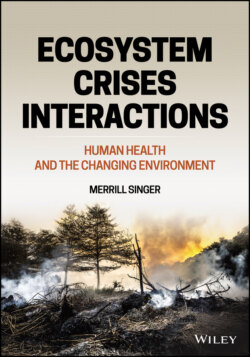Читать книгу Ecosystem Crises Interactions - Merrill Singer - Страница 22
1.8 Sustainability of human life on Earth
ОглавлениеUltimately, ecocrises threaten the sustainability of human life on Earth. Already, research suggests that Earth may be in the midst of its sixth mass extinction of species, in no small part because of the human reshaping of the environment. At this point in our history, the idea of pristine environments untouched by our presence is an illusion. We have left an indelible impression everywhere on the planet; there are no hidden natural sanctuaries that are unsullied by the effects of human society and activity. Archeological, paleoecological, and genetic research suggests that:
As our planet experiences its sixth “mass extinction event” … the effect of anthropogenic landscape modification, habitat fragmentation, overexploitation, and species invasions could not be more apparent … These transformations are linked largely to the industrial economies, burgeoning populations, and dense transport networks of contemporary human societies.
(Boivan et al. 2016)
In fact, Boivan et al. (2016) stress, the human‐mediated alteration of Earth long predates the rise of industrial economies. Relative to our impact on other species, they identify four pivotal phases in the loss of pristinity: 1) the Late Pleistocene near‐global dispersal of our ancestors; 2) the emergence and spread of agriculture and livestock domestication beginning in the Early Holocene; 3) the human colonization of the world’s islands; and 4) the premodern expansion of urbanization and trade beginning 5000 years ago during the Bronze Age. While socioeconomic developments since the Bronze Age have dramatically accelerated the magnitude and range of the human impact, all of these prior moments in the making of a human‐dominated Earth are significant.
A significant biological effect of the Late Pleistocene expansion of our species, for example, was felt by larger animals or megafauna, those weighing over 100 pounds. While there is debate concerning the extent of the human role in the extinction of about 90 megafauna genera in the period between 50 000 and 10 000 years ago (Koch & Barnosly 2006), new analytic approaches affirm at least some direct human role through hunting in the disappearance of animals like the giant ground sloth, woolly mammoth, saber‐tooth cat, a giant 6‐foot‐long beaver, and the 3‐ton Diprotodon, the largest marsupial that ever lived. This research suggests an inverse relationship between the severity of the extinction and the duration of hominin–megafauna contact.
If hunting only partly accounts for the megafauna extinctions, what else was involved? According to Koch & Barnosky (2006, p. 239):
Taken as a whole, recent studies suggest that humans precipitated the extinction in many parts of the globe through combined direct (hunting) and perhaps indirect (competition [for food or habitat], habitat alteration and fragmentation) impacts, but that … environmental change influenced the timing, geography, and perhaps magnitude of extinction. Put another way, absent the various impacts of Homo sapiens … it is highly unlikely global ecosystems would have experienced a mass extinction of large, slow‐breeding animals in the late Quaternary. But, absent concurrent rapid climatic change evident in many parts of the globe, some species may have persisted longer.
In other words, it is likely that it was the interaction of human hunting and climate change that eliminated or fragmented the environmental conditions necessary to maintain the megafauna, leading to their extinction.
Without question, the vast majority (99 percent) of species that have ever lived are now extinct (Novacek 2001). Human presence on the planet is not guaranteed; indeed, like all species, and despite our comparatively big brains and powerful technologies, we are dependent upon our fragile relationship with the environment. Failure to fully appreciate this simple truth and move with determination to more sustainable socioeconomic systems will place our near future at grave risk. This idea touches on a broader question about lifeforms elsewhere in our galaxy: namely, why, with all of our searching (e.g., NASA probes, monitoring of electromagnetic radiation, the work of the SETI Institute), have we not encountered signs of alien civilizations? One explanation, known as the Great Filter theory, is that extraterrestrial civilizations may emerge, develop, and destroy their environments, and hence themselves, too quickly for us to find them, or vice versa. In other words, the Milky Way may be sprinkled with extinct alien civilizations that were wiped out by self‐induced environmental destruction.
